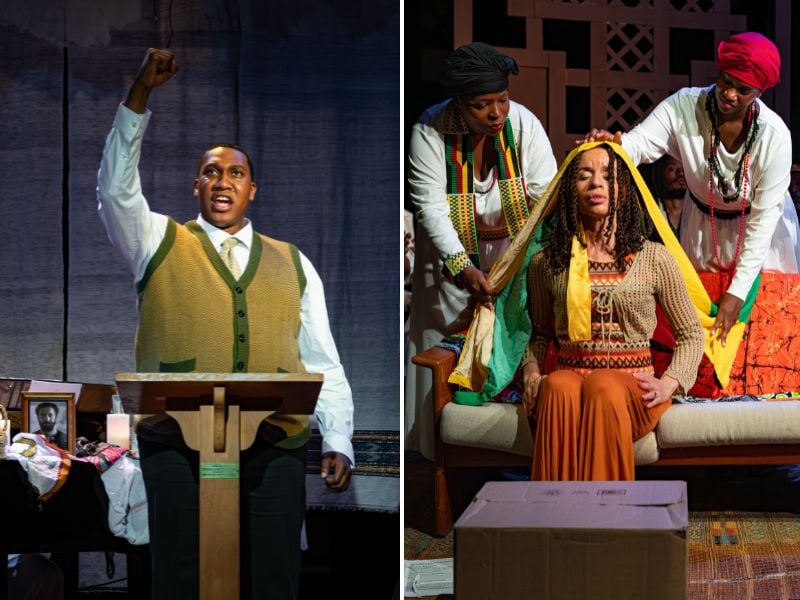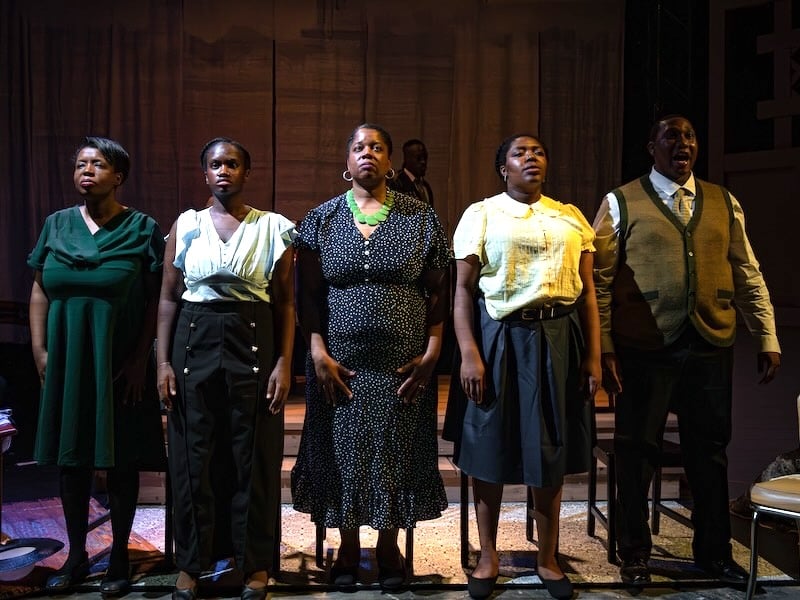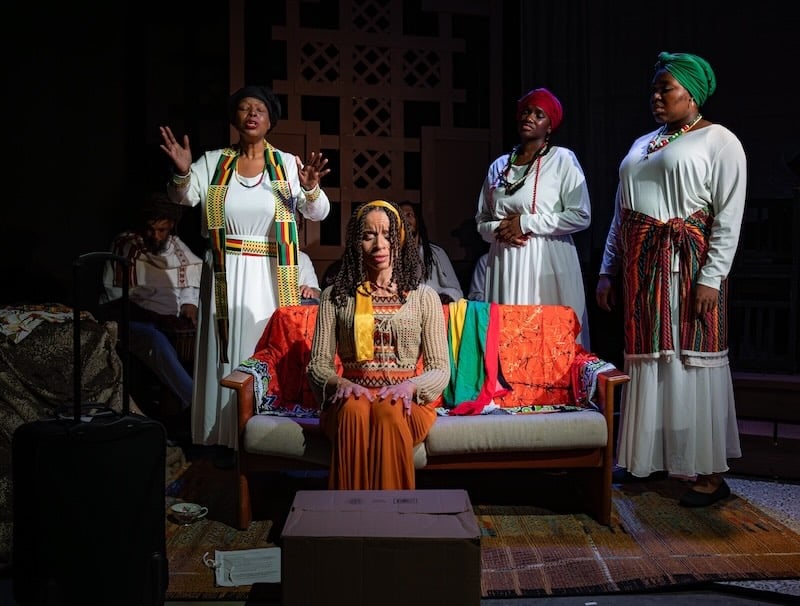In 1935, President Franklin D. Roosevelt’s Works Progress Administration established the Federal Theatre Project to fund live entertainment and employ out-of-work theater artists during the Great Depression. One of the Federal Theatre Project’s first initiatives was the creation of “Living Newspapers” — collaborating with journalists in creating stage works drawn from speeches and newspaper headlines of the day. The first Living Newspaper, Arthur Arent’s Ethiopia, an account of the Italian invasion of Haile Selassie’s Ethiopia and the global response, was set to open in January 1936. When the Living Newspaper’s creators attempted to obtain a recording of one of FDR’s speeches to conclude the play, the Roosevelt administration issued a directive that “no one impersonating a ruler or cabinet shall actually appear on the stage,” effectively censoring a work that featured multiple world leaders (including Benito Mussolini) and cabinet members. Ethiopia was canceled after a single dress rehearsal and never appeared on the American stage — until now.

Nearly 90 years after Arent’s Ethiopia was shut down by the FDR administration, IN Series mounted the first production of Ethiopia as the final installment in its 2024/25 season, Illicit Opera, featuring works banned at the time of their creation. Two weeks prior to opening night, in an eerie echo of 1936, the National Endowment for the Arts under President Donald Trump’s administration canceled its funding for the show. Yet IN Series, with the support of private foundations and donors to its emergency “Save ETHIOPIA” campaign, soldiered on to open the production on schedule last weekend in Theater Alliance’s pop-up space at The Westerly at DC’s Southwest Waterfront. (The production moves to Baltimore Theater Project from May 30 to June 1.)

IN Series’ version of Ethiopia, directed by Artistic Director Timothy Nelson, presents Arent’s Living Newspaper as the first act, with a second act written in response by Sybil R. Williams, playwright, dramaturg, and director of African American and African Diasporic Studies at American University. Each of the cast members (Ezinne Elele, Elise Jenkins, Madison Norwood, Shana Oshiro, Daniel J. Smith, Nakia Verner, and Marvin Wayne) moves fluidly between multiple roles, with all save Oshiro appearing in both acts. In a testament to the cast’s flexibility and IN Series’ determination that the show must go on, when Oshiro lost her voice during opening weekend, Norwood voiced many of her lines from stage right while Oshiro performed her characters through mime, conveying wordless emotion through her expressive face and movements.
The first act moves quickly between the Ethiopian highlands, the League of Nations in Geneva, and the cities of Europe and the United States, conveyed by newspaper headlines and black-and-white photographs projected behind the actors (Hailey LaRoe, projections designer). Rakell Foye’s costumes feature simple white button-down shirts and dark-colored pants and skirts for the cast in the first act, with sashes denoting the country each actor represents in the League of Nations meetings. Smith stands out as Ethiopian Emperor Haile Selassie, appearing before the League in a navy-blue coat bedecked with military medals. As world leaders from France, England, and the USA refuse to take meaningful action in support of his country when Italy invades Ethiopia, Smith as Haile Selassie addresses both the diplomats on stage and the audience off it with regal posture and piercing gaze as he says, “It is far better to die on the field of battle, a free man, than to live as a slave!”
This viscerally expressed desire for freedom by the African peoples of the world unites Arent’s first act with Williams’ response, which illuminates the response of African Americans (and diasporic Africans worldwide) to Ethiopia’s struggle against Italy’s attempted colonization. Where the first act plays out in the black and white of 1930s newspapers, the second act springs to life in brilliant color. The set design (by Tsedaye Makonnen, Adrienne Gaither, and Kathryn Kawecki) shifts to include latticework evoking the traditional meskel (cross) designs of the ancient Ethiopian Orthodox Church, and a backdrop of Ethiopian textiles. Verner takes center stage in the second act as Mayme Richardson, an African American opera singer from Michigan who traveled the world and performed for Emperor Haile Selassie and his wife, Empress Menen. Captivated by the “spirit of freedom, untrammeled freedom!” that she felt on Ethiopian soil, Richardson spread the word to Black people in the United States and in the Caribbean of a land grant offered by the Emperor to the African diaspora in appreciation of their support for the Ethiopian resistance to the Italian invasion. Oshiro plays Chloe, a fictional descendant of Richardson’s who begins to explore her African heritage through uncovering the story of her ancestor’s travels and adopts the Ethiopian name Tsehay (meaning sunshine). She is guided by a pan-African chorus (Elele, Jenkins, and Norwood) who appear wearing beads, sashes, and headwraps in green, gold, and red, and quoting Rastafarian prayers, weaving in yet another Black diasporic thread linked to, and inspired by, Ethiopia.

Janelle Gill’s musical score is the thread that ties both acts — and the many expressions of Blackness contained in the play — together. From African American spirituals sung by the cast, to Ethiopian masenqo played by Woretaw Wubet, to Rastafarian nyabinghi drumming by Baba Ras, to literal drumbeats of war accompanying the Living Newspaper headlines, Gill’s score adds depth to the storytelling at every turn. That she performed at the piano dressed all in white and with her head covered in the traditional netela headscarf, as Ethiopian women do in church, further underscored the feeling that a sacred story was being told on stage.
Playwright Williams noted in a recent interview that this production of Ethiopia “is really a first draft, and there are many threads that I am still weaving.” The historical, political, cultural, and artistic threads are so numerous that some may be easy to miss, and audiences could have benefited from more comprehensive director’s or playwright’s notes in the program or opportunities for Q&A. A planned talkback at the performance I attended on Saturday was scrapped when the show ran nearly 30 minutes over its stated time.
Ethiopian American mixed media artist Mygenet Tesfaye Harris, whose works (along with ceramic artist Ayda Biru’s) were displayed in the lobby at the DC performances, noted that the collection she chose to accompany IN Series’ production is titled “Wax & Gold” after an Amharic phrase deeply embedded in Ethiopian literary and cultural tradition and referring to “unseen complexities and symbolism … below the surface.” Williams’ (and IN Series’) expansion of Arent’s original Living Newspaper is a richly layered work of art that explores the unseen complexities and symbolism beneath the original 1930s headlines and prescient warnings against fascist aggression, to illuminate the ancient culture and history of Ethiopia itself and the complexities of the pan-African movements it inspired. Wax and gold, indeed.
Running Time: Approximately two hours and 30 minutes, including one intermission.
Ethiopia played from May 16 to 18, 2025, presented by IN Series, performing at 340 Maple Drive (DC Waterfront/Wharf), Washington, DC.
Ethiopia plays May 30 to June 1, 2025, at the Baltimore Theatre Project
45 W Preston St, Baltimore, MD. Tickets (general admission, $30; student, $20) are available online.
The program for Ethiopia is online here.
Ethiopia
A Living Newspaper by Arthur Arent
A New Play by Sybil R. Williams
With New Music by Janelle Gill
Stage Director: Timothy Nelson
Music Director and Composer: Janelle Gill
Costume Designer: Rakell Foye
Set Designers: Kathryn Kawecki
Design Artists: Tsedaye Makonnen and Adrienne Gaither
Lighting Designer: Alberto Segarra
Projections Designer: Hailey LaRoe
Stage Manager and Lightboard Operator: Mikayla Talbert
Production Manager: Paige Washington
Technical Director: Megan Amos
FEATURING
Ezinne Elele
Elise Jenkins
Madison Norwood
Shana Oshiro
Daniel J. Smith
Nakia Verner
Marvin Wayne
MUSICIANS
Jabari Exum, Dave Foreman, Baba Ras, and Woretaw Wube
SEE ALSO:
A look inside ‘Ethiopia,’ a world premiere Living Newspaper at IN Series
(interview by artistic director Timothy Nelson with playwright Sybil R. Williams, May 12, 2025)



